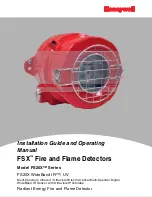
Installation Guide and Operating Manual // Model FS20X™ Series
Honeywell
12
Detector Connections
(continued)
ATTENTION
:
FSX Power-Up
– After the application of 24 VDC power or resetting the Detector, wait a
mimimum of (thirty) 30 seconds to allow the Detector’s sensors to normalize to the
spectral background conditions.
FSX Testing
- As with any intelligent IR Detector, please wait a minimum of thirty (30) seconds
between tests (i.e., butane lighter, FSC test lamp, or test fires) to allow the Detector’s
sensors to normalize to the spectral background conditions.
Changing the Detector Settings
– To activate changes to the settings using SW1, SW2 and SW3,
reset the Detector by removing and re-applying 24 VDC input power.
1.
Verify that the external 24 VDC power is turned
U
OFF
U
before connecting the Detector.
2.
Avoid wire splices whenever possible. If wire splices are required, solder and properly insulate them.
Good wiring practices simplify installation, improve reliability, and facilitate maintenance.
3.
For applications requiring analog/digital communications, refer to Section 3.2.
2.4 Installation
Practices
For installations in a Hazardous Classified Area, consult the National Electric Code Handbook, Articles 500
through 517 for the proper installation practices. For locations outside of the United States, observe local
and/or regional regulations.
IMPORTANT
U
: The Detector’s metal conduit plug by itself cannot make a weather-tight seal. Metal-to-metal
does NOT provide protection against the ingress of moisture. It is necessary to obtain an approved material
to apply to the threads in order to maintain the “weather-proof” integrity and satisfy local/regional regulations.
Figure 2-12
Terminals





























